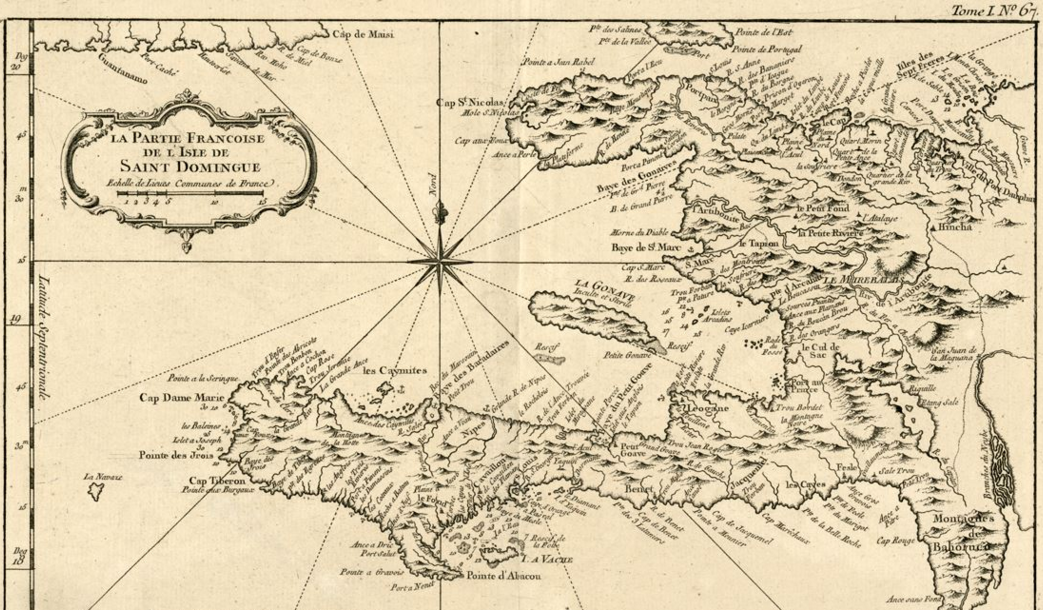
Môle St. Nicolas on the island of Santo Domingo, seen from the mooring (author Ozanne, public domain)
The Acadian refugees in Tropical America
In February 1763, after the Seven Years’ War, the Treaty of Paris ended the French presence in North America. France kept only the small archipelago of St. Pierre and Miquelon and its fishing rights in Newfoundland. But it preserved its main possessions in Tropical America, namely Guiana, Santo Domingo, Guadeloupe, Martinique and St. Lucia. For the Duke of Choiseul, Secretary of State for War and Navy, the Treaty of Paris was an unexpected diplomatic success. The wide French colonial trade was saved, at least in appearance…
In reality, the French authorities were only thinking of consolidating what was left of their colonial empire, founded on slave plantation colonies and an abundant African slave labor force. This system was, however, deeply threatened by the persistence of marronnage (runaway slaves) and the violence exercised against Whites by certain African slaves and free Blacks. After 1763, the French authorities decided to encourage the mass migration of white free workers, considered to be loyal subjects. This new strategy was based on a newly born doctrine promoted by some economists (the “physiocrats”), according to which all wealth comes from the land and the only productive class is that of the farmers. Wealthy farmers, skilled in agriculture, were given land as well as white peasants to work it, in proportion to the capital invested. The peasants were given small plots of land, but they had to raise livestock and grow food crops on behalf of all-powerful landowners for whom they were employed. In this scheme, slavery had no place…
The New Colony of Guiana

From February 1763, it was this scheme that was adopted as a priority for the New Colony of Guiana. With 5,000 black slaves and only 750 Whites, Guiana was in dire need of heavy investment. Choiseul appointed two followers of the physiocracy, one as governor, the other as intendant of the New Colony. He even went so far as to ban the importation of black slaves, to dissuade the new landowners from resorting to large cash crops like sugar, coffee or indigo. But now there was a major challenge. It was necessary to recruit 10,000 white settlers, serving a handful of all-powerful landowners, to settle at the mouth of the Kourou River, the site chosen for the New Colony, north-west of Cayenne…
Choiseul very quickly turned to the Acadians who had taken refuge in France, promising them arable land in Guiana and, before their departure, a bonus of 50 pounds per family with one child, increased by 10 pounds per additional child. The offer seemed tempting, as they could continue to receive the subsidy they were paid in France. However, did they really have a choice, since if they refused, Choiseul threatened to cut their subsidy? The Acadians were reduced to forming a captive and docile workforce, but secure and cheap. Indeed, the premium paid per family was much lower than the price of a healthy African slave, that is 2,000 pounds. The other migrants, much more numerous, recruited at France’s eastern borders, were mostly German-speaking settlers from Rhineland-Palatinate and Alsace…
Unfortunately, upon their arrival in Guiana, in the first months of 1764, the colony was not ready to receive all these migrants. In consequence, it experienced a real humanitarian disaster, the deadliest in the history of European colonization of the Americas. The number of white settlers, all volunteers, sent to Guiana is estimated at 14,000, most of whom perished from disease or malnutrition during the trip or in the first months following their arrival in the colony. Among the surviving settlers who remained in Guiana, Acadians succeeded in forming prosperous local communities on the fringes of Guyanese Creole society. This is the subject of the first of three articles devoted to Tropical America: “Kourou (Guiana) – From disaster emerged a Guyanese Acadia”.
Môle St. Nicolas

At the same time, in February 1764, more than 500 Acadians arrived at Môle St. Nicolas, an abandoned site at the western end of the northern peninsula of the colony of Santo Domingo. This second major post-war colonial project was not lacking in panache. Môle was situated in a strategic location controlling navigation between the southern coast of Cuba and Jamaica. Was the French authorities’ ambition excessive? Môle was to operate as both a military base and a colony of white farmers. As colonists, the Acadians had been considered more capable than the regular French migrants. Nonetheless, it was still necessary to move from theory to practice.
In July 1764, when the governor of Santo Domingo made his first visit to Môle, he thought he would find a prosperous colony. On the contrary, he was distressed by the sad spectacle that presented itself to him. This is the subject of the second of three articles devoted to Tropical America: “Môle St. Nicolas (Haiti) – When greed is added to improvisation”.
The short-lived colony of Champflore
In the other French territories in tropical America, the Acadians especially did experience a short-lived episode of colonization in Martinique. This is the subject of the third article devoted to tropical America “Morne-Rouge (Martinique) – The ephemeral colony of Champflore”.
Guadeloupe and St. Lucia were not favored destinations by the Acadians, although some traces of their passage do remain.
List of the Acadian communities
